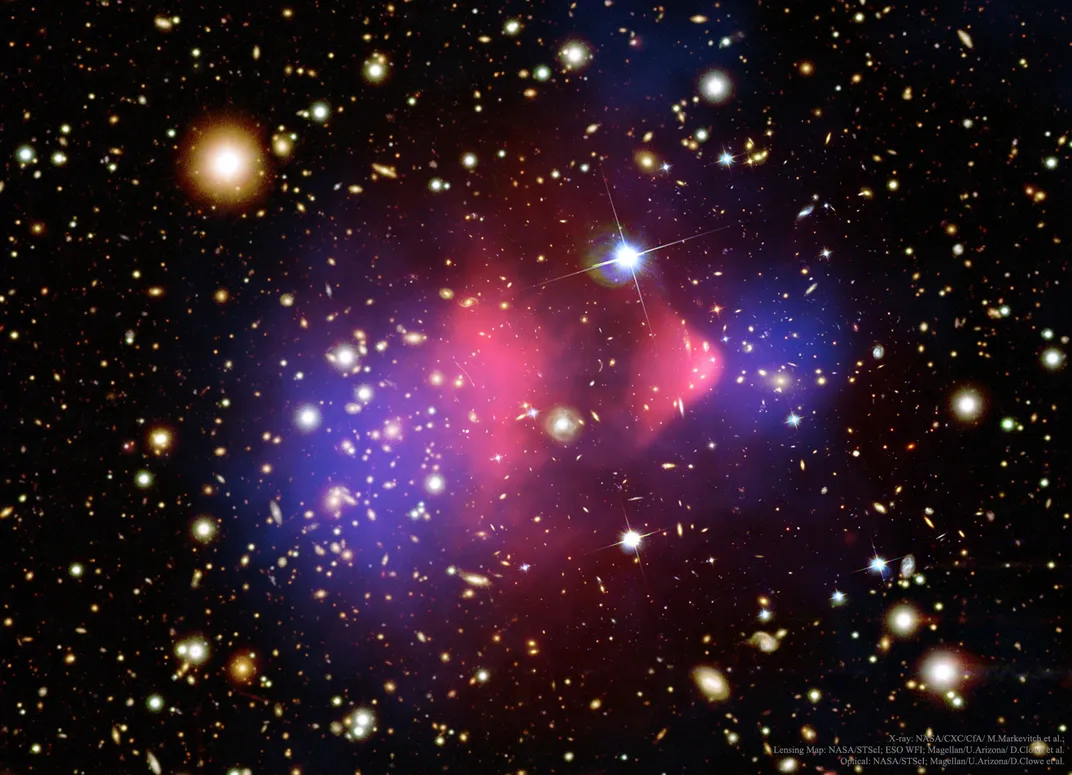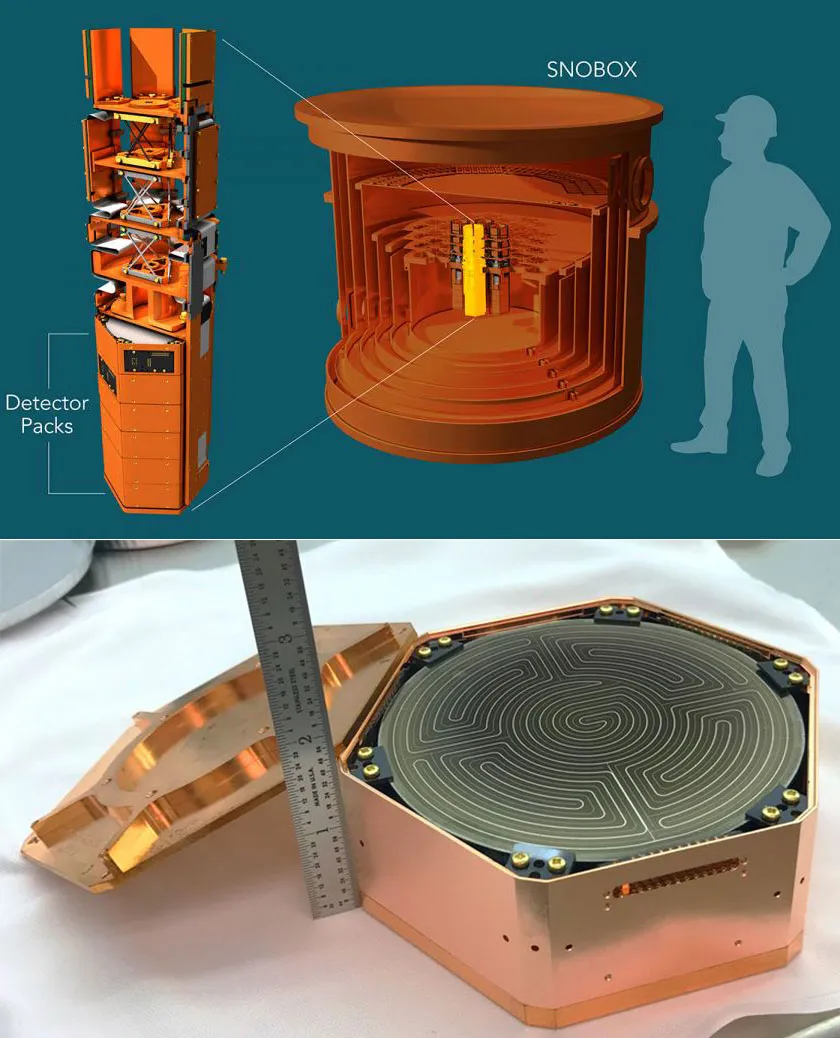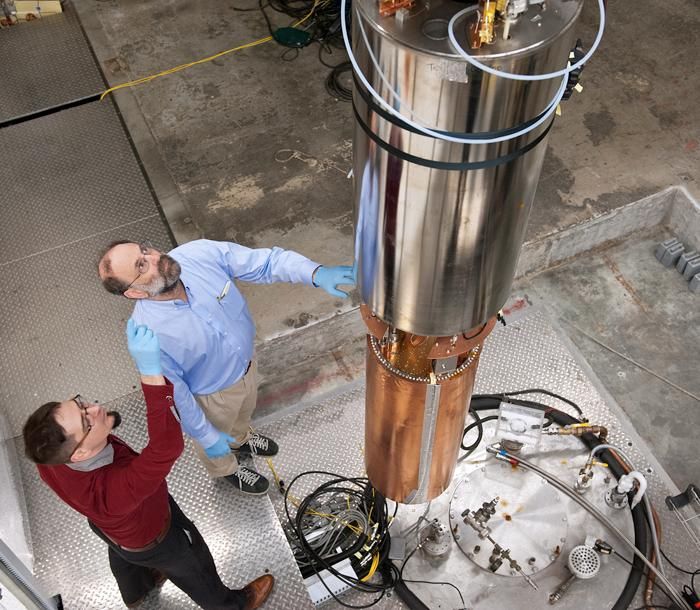New Generation of Dark Matter Experiments Gear Up to Search for Elusive Particle
Deep underground, in abandoned gold and nickel mines, vats of liquid xenon and silicon germanium crystals will be tuned to detect invisible matter
/https://tf-cmsv2-smithsonianmag-media.s3.amazonaws.com/filer/42/d5/42d5a303-b006-4972-9efa-92797a25ba9c/31667821088_f762d2c200_o.jpg)
This spring, ten tons of liquid xenon will be pumped into a tank nestled nearly a mile underground at the heart of a former gold mine in South Dakota. With this giant vat of chemicals, scientists hope to detect the historically undetectable, a mysterious substance that makes up more than 85 percent of all mass in our universe: dark matter. “One of the annoying features of dark matter is we have really no idea [what it is],” says Murdock Gilchriese, project director of this experiment, known as LUX-ZEPLIN (LZ). “We know it exists, but as a particle and what its mass is, there’s a huge range.”
LZ is one of three major experiments funded by the DOE and NSF that aim to directly detect dark matter, a goal that has tantalized scientists for over thirty years. While past experiments such as LUX, the predecessor to LZ, came up short, this next generation of projects hopes to tackle the challenge using systems with unprecedented scale and sensitivity.
“You could say we’re the world’s best at finding nothing. I mean, people have said that and so far, it’s actually true,” Gilchriese says. “It very well may be that people spend ten years plus and we find absolutely nothing.”
The concept of dark matter originated in the 1930’s when astronomer Fritz Zwicky tracked the velocities of over 1,000 galaxies clustered together and observed that the gravitational pull from visible matter alone wasn’t strong enough to keep the cluster from flying apart. He posited that there must be matter that we can’t see—dark matter—that contributes most of the gravitational force that holds everything in place. Forty years later, astronomers Vera Rubin and Kent Ford found more evidence of dark matter by studying the motion of stars within spiral galaxies. They found that stars orbiting at the outer edges of these galaxies moved just as quickly as those at the center, possibly due to a halo of dark matter providing an extra gravitational pull. Most recently, a photograph of two colliding galaxies, nicknamed the Bullet Cluster, exhibited a gravitational lensing effect—light that is bent due to immense gravity—that could not be explained by visible matter alone. Scientists say that these observations strongly point to the existence of dark matter, but exactly what that matter is made of remains a mystery.

“[Dark matter] is not just a hope—there [are] clues to this,” says physicist Priscilla Cushman, spokesperson for another dark matter detection experiment called SuperCDMS SNOLAB. “We know how much there is because it’s got this immense influence due to gravity. … It affects the whole evolution of our universe from the Big Bang on, because if it weren’t there, we would not have the clumpiness we see currently when we look out at the clusters of galaxies. That extra gravity, which is created by the dark matter particles, is necessary to form the structure we see today. So there’s tons and tons of evidence.”
Gravity is only one of the four fundamental forces of nature available for dark matter to interact with. “We know it does not interact electromagnetically, that’s why we call it dark, otherwise we’d see it,” Cushman says. She explains that it also does not interact through the strong nuclear force, which holds atomic nuclei together, “because then we’d be dead.” (In other words, atoms would not be stable.) The remaining candidate is the weak nuclear force, the mechanism by which subatomic particles interact with one another and how atoms undergo radioactive decay. To find dark matter, physicists like Cushman are banking on the particles to interact with normal matter through the weak force.
The search for dark matter forms what Cushman calls a “three-legged stool of experiments.” The first leg is indirect detection, which attempts to observe signals coming from deep in the universe, like gamma rays, that might have sprung from the annihilation or decay of dark matter particles. Scientists have also been trying to create dark matter particles by crashing two high-energy protons into one another in the Large Hadron Collider, mimicking what might have occurred at the Big Bang when all these particles formed. Finally, direct detection experiments like LZ and SuperCDMS hope that dark matter particles occasionally interact with normal matter via the weak force, allowing them to be spotted by extremely sensitive detectors. Since the characteristics of dark matter particles are completely unknown, researchers trying to detect dark matter directly essentially make an educated guess about what mass their detectors should be looking out for.
“The problem with all of this is you’re looking for something, a needle in a haystack,” Cushman says. “To build a detector, you need to make some assumptions about how shiny is the needle, and how big it is, and where the haystack says you should start looking first. So that’s what we do when we build these detectors. We think of the most likely place, and of course we could be wrong. And so as time moves on, and we don’t find the needle where we expected to find it, we look further and deeper into the haystack.”
* * *
The most widely known dark matter candidate is the weakly interacting massive particle, or WIMP. WIMPs first gained popularity after theoretical physicists noted that if weakly interacting particles roughly 100 times more massive than a proton were created in the Big Bang, their total density today would account for all of the estimated dark matter in the universe, a coincidence called the “WIMP miracle.”
“Once the universe got big and cold, the weak interaction gives you the relative density we have left,” Cushman says. “[The] model is only a coincidence, but it’s very suggestive, and that started the whole looking for these WIMPs because they would be perfect.”
LZ and SuperCDMS are both tailored to detect WIMPs. However, given the broad range of possible WIMP masses, the two experiments use drastically different approaches in order to target different mass scales.
/https://tf-cmsv2-smithsonianmag-media.s3.amazonaws.com/filer/cb/d6/cbd6be63-d5c4-43c2-a8cb-085f5148bf84/lz-and-snolab.jpg)
SuperCDMS, which is slated to begin its search in late 2020, probes the lightest WIMP masses, ranging from a fraction of a proton mass to ten proton masses. Located 6,800 feet underground inside a nickel mine in Ontario, the initial experiment will use four towers that each contain six detectors made from crystals of silicon germanium to attempt to sense dark matter. The facility is expected to house over 30 towers as the experiment expands over the next decade.
If a WIMP hits one of the detectors, the collision will (theoretically) disturb electrons throughout the crystal lattice, creating more vibrations and amplifying the initial crash. This amplified signal will then be picked up by sensors which alert the researchers that a collision occurred. Even the smallest interference, which physicists call “noise,” could disturb the experiment by triggering false signals. As a result, the researchers must take extreme precautions, such as cooling the detectors to below minus 450 degrees Fahrenheit (nearly absolute zero) to avoid thermal vibrations, and building shields that block out interference from cosmic radiation particles hitting the planet from space.
“Understanding background [noise] is … a very, very big challenge,” Cushman says. “Anticipating all the ways in which you can get a few signals into the detector that you didn’t intend to—[say] you build a shield—does the shield itself create more background [noise] than is being eliminated from the outside?”
Cushman explains that over the next ten years, SuperCDMS aims to become so sensitive that it can even detect neutrinos, electrically neutral particles with almost incomprehensibly small masses that are formed by radioactive decay, such as nuclear reactions within the sun. At that point, the experiment will encounter unprecedented challenges in blocking out background signals, as the neutrinos will resemble dark matter particles more than any other type of interference.
“Since [neutrinos] are so light mass, we always assumed that we didn’t have to worry about them because we weren’t sensitive enough to see them,” Cushman says. Previous experiments looked for dark matter particles in higher mass regions where interference from neutrinos could be ignored. “But now that we’re getting sensitive enough, we’re actually turning into neutrino detectors, if you will.”

At the other end of the possible WIMP range, LZ targets heavier particles with masses between a few protons up to tens of thousands of protons. The experiment consists of ten tons of liquid xenon (nearly a quarter of the world’s annual supply) surrounded by a Russian doll of shielding—a titanium container with the xenon placed within a second container filled with liquid that absorbs gamma rays, all within another container holding 70,000 gallons of water.
“When a dark matter particle, hopefully, interacts with xenon, it creates both light and electric charge,” Gilchriese says. The researchers detect the initial burst of light, and then the electric charge drifts upward for more than a meter, where it is detected by 500 sensors. Information from these two signals will allow the researchers to calculate both the energy and location of the initial collision. Locating where the collision took place is critical, since it would reveal whether the signal caused by interfering noise outside the container, or from a collision at the center of the pure xenon bath, where the researchers believe only a dark matter particle could reach.
Like SuperCDMS, LZ faces the significant challenge of eliminating background signals from radioactivity. “The biggest obvious difference [between LZ and its predecessor] is that it’s 30 times more xenon. But buying 30 times more xenon is easy, it just requires money,” Gilchriese says. “Really it’s this pervasive necessity to understand where radioactivity sources are, from everything that goes into the experiments, and there’s thousands of pieces. … You have to take extraordinary steps to limit your exposure to just, you know, air.”
Other groups outside the United States, such as the XENON project in Italy and PandaX-II in China, are also racing to find WIMPs using liquid Xenon. Once LZ turns on midway through 2020, scientists from around the world will likely be holding their breath in anticipation of a detected signal.
“Suppose we see something, right? Well, the next step would be to build an even bigger [experiment] because we want to see more,” Gilchriese says. “If you don’t see anything, then you have some interesting choices. Do I spend hundreds of millions of dollars to make a big version of LZ, or do I spend 10 or 100 million dollars expanding my ability to look at different mass regions? It’ll depend on what we see over the next five years.”
* * *
Despite projects like LZ and SuperCDMS, which have a better chance of detecting a weakly interacting massive particle than anything that came before, the WIMP has drawn a crowd of skeptics in recent years due to the lack of results from the Large Hadron Collider and previous liquid xenon experiments. “People are nervous about the WIMP, but they’re just being nervous,” says Leslie Rosenberg, a physicist from the University of Washington. “It would not surprise me if LZ and/or SuperCDMS found the WIMP. I think the community would be surprised because they don’t think big. They get up in the morning, they have their coffee, they read the paper, they go to work, et cetera. … So day-to-day, they don't think about the possibilities. They don't see the light.”
Although Rosenberg might believe in WIMPs, he’s not looking for them. Instead, he leads a project called the Axion Dark Matter Experiment G2 (ADMX G2), housed at UW, that hunts for an alternative dark matter candidate called the axion, which he calls “a completely different beast.”
Born out of a theory proposed by Roberto Peccei and Helen Quinn in the 1970’s, the axion was predicted to be nearly one trillion times less massive than an electron, producing such a feeble interaction that it earned the moniker “the invisible axion.” Unlike WIMPs, however, axions are predicted to decay into two photons over timescales that extend far beyond the age of our universe.
The trick to detecting invisible axions is speeding up this decay process, an idea originally suggested by theoretical physicists Pierre Sikivie and Lawrence Krauss. Though invisible, axions are an ample resource—if they exist—with over ten trillion axions per cubic centimeter around you, by Rosenberg’s estimates. “That’s a fabulous thing to think about, that you’re just literally in an ocean of axions, and you have no clue that they’re there.”
To produce a signal out of this ocean, Sikivie and Krauss suggested that one could simply use a magnetic field to scatter the axions and speed up their decay into photons, which could then be detected. The conversion rate could be increased even further by surrounding the space with a resonator, or a device that produces a certain microwave frequency, which could be tuned to correspond to the particular mass of axion that researchers are looking for.

Although axions have been theorized for over 30 years, the real experimental breakthrough occurred in the early 2000s with advances in quantum electronics, Rosenberg says, which allowed scientists to reduce the noise in their system and obtain the sensitivity required to detect these “invisible” signals. Today, Rosenberg’s team is aggressively pursuing the particle, sweeping through an entire frequency bandwidth every nine months before replacing their resonator with a new one that searches for the next axion mass in their lineup.
“In all these experiments—LZ, SuperCDMS, ADMX—we all have a sense that in our data, we could find it at any time. And we’re very serious about that,” Rosenberg says.
Although the projects focus on significantly different hypothetical particles, Rosenberg says that it is entirely possible for dark matter to consist of both WIMPs and axions, as well as other candidates. “They aren’t mutually exclusive. … Maybe God in her infinite wisdom made the universe that complicated,” he says. “One day nature might tell us that dark matter is a mix of WIMPs and axions, and messy or not, that’s what she said.”
Gilchriese holds similar views about LZ in comparison to experiments like ADMX. “Axions look at very, very tiny masses, whereas we look at as heavy as you can get. They’re completely different experimental techniques, looking in completely different places, and you need them both,” he says. “Since we don’t actually know what’s going on, the more the merrier.”
With ADMX rapidly exploring one axion mass after the next, and SuperCDMS and LZ gearing up for a new era of research searching for WIMPs, an unsettling question lingers in the air. What if, after all the years and millions of dollars, a signal never comes? What if the only result is finding out that a dark matter particle does not exist where we thought it would?
“Every time that we get to a higher sensitivity and don’t see something, we have made some very definitive statements about the nature of dark matter,” Cushman says. “They’re negative statements, if you like, but they are absolutely changing the way we look at the world. And without those negative statements, we would not try for another model. We would not say that we have to work harder for something different than what we thought it might be.”
For Rosenberg, the daily promise of discovery is enough to keep him buoyed against doubt in what could be physics’ longest waiting game. “This idea that 90 percent of mass is not anything that we know … [that] it’s some new thing, some exotic thing. And finally, we could see it,” he says. “How do you not get excited by this? The only thing that gets me up in the morning so I can crawl out of bed and have my coffee is this experiment and this idea.”
In the meantime, the rest of us can drink our coffee from the sidelines, waiting while scientists rush to find the matter that makes up most of the universe, one hypothetical particle at a time.

